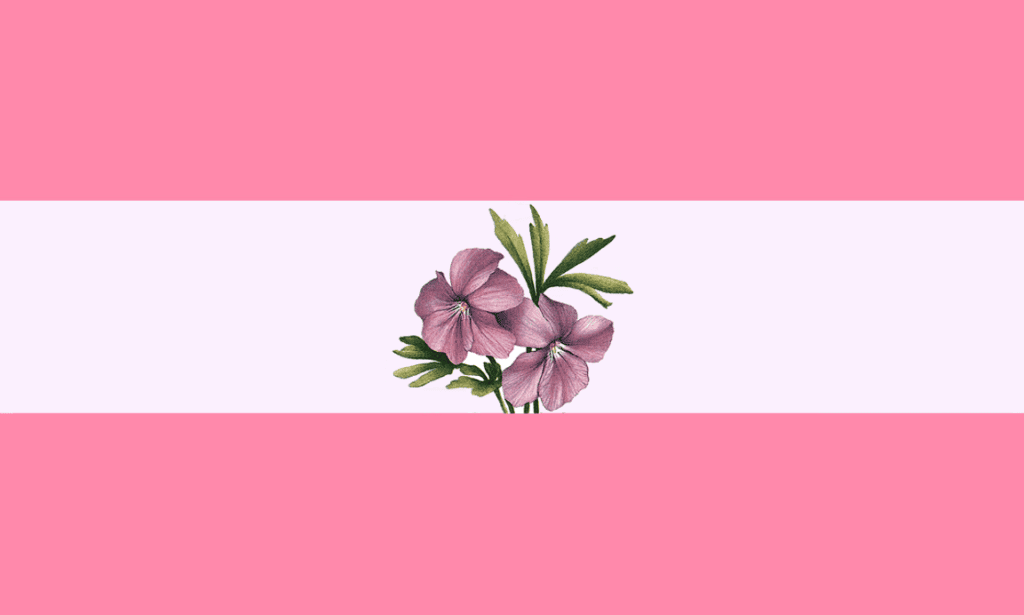What does sapphic mean, and how does the flag look?
You may have heard the term sapphic floating around or even seen the sapphic flag, but are you unsure what that means? Don’t worry! The queer community is constantly becoming more inclusive and normalizing detailed ways to describe your gender or sexual identity.

Sapphic meaning
The term sapphic is used to encompass a wide range of sexual and romantic orientations, including but not limited to lesbian, bisexual, pansexual, wlw (woman-loving-woman), and queer. It has been adopted as an umbrella term that includes non-binary individuals, cis women, and trans women as well.
This term describes romantic connections and emotional bonds between women or non-binary people, expanding the definition of inclusivity beyond traditional cisgender identities. It is used to highlight the diverse experiences of individuals within the queer community and serves as a descriptor for a range of relationships, emotions, and identities. Overall, the term sapphic promotes greater acceptance and understanding of the complex and diverse nature of human sexuality and relationships.
Key Sapphic Terms
Sapphic sexuality: Refers to a sexual orientation characterized by an attraction to women and/or non-binary people.
Sapphic pansexuality: Describes individuals who are attracted to people of all genders, with a particular emphasis on women and/or non-binary people.
Sapphic romance: Encompasses the romantic aspect of relationships between women and/or non-binary people, emphasizing emotional connection and intimacy.
The beauty of the term "sapphic" and platforms like LesPark lies in their inclusivity. They embrace a spectrum of identities, from lesbians to bisexual women to pansexual individuals, and acknowledge the diversity of experiences within the sapphic community. They also welcome those who may not fit neatly into traditional labels, offering a space for self-discovery and connection.
What is the origin of sapphic?
Prepare to be transported back in time to the 7th century BCE and discover the long history and captivating world of Sappho, the legendary Greek poet who revolutionized the literary landscape with her unapologetic expressions of same-sex desire. Sappho’s poetic prowess and intense emotional depth have immortalized her as a symbol of passion and love between women, inspiring poets, scholars, and the queer liberation movement for centuries to come.
Though societal norms of her time forbade open declarations of queerness, Sappho’s verses dripped with ardor and longing for her female companions, defying the constraints of her era. Her innovative poetic form also contributed to her legacy, as she is credited with inventing the sapphic stanza, a four-line metrical structure characterized by its rhythm and meter.
But Sappho’s influence extends far beyond her thematic exploration of female desire; her nuanced perspective suggests that she existed within a fluid spectrum of sexuality, encompassing elements of queerness, bisexuality, and pansexuality. As such, the term “sapphic” offers a broad umbrella under which all individuals who love women—regardless of their gender identity or sexual orientation—can find recognition and validation.
Today, Sappho’s enduring legacy lives on in popular culture through various art forms (from visual arts to the written word), symbols, and artifacts, including the iconic sapphic flag. The flag serves as a visual reminder of the rich tapestry of sapphic identity and the collective pride of those who identify with this heritage.
Now that you know who Sappho is, you can impress your HER date with some 7th-century love poems. It’s what Sappho would want!
Sapphic flag
The evolution of the sapphic flag is a testament to the enduring legacy of Sappho and the vibrant spirit of the LGBTQ+ community. Designed to embody the essence of sapphic love and solidarity, the flag’s symbolism is rich with meaning and history.
The sapphic flag consists of two bold pink stripes at the top and bottom, representing the boundless depth of love shared between women. These hues, infused with warmth and passion, evoke a sense of connection and unity within the sapphic community.
At the heart of the flag lies a delicate violet, historically associated with sapphic love. This flower symbolizes the profound emotional bonds shared between women and has long been revered as a token of affection and devotion.
Some iterations of the sapphic flag feature a pair of violets nestled lovingly at its center, paying tribute to the unique and cherished connections forged within sapphic relationships. This celebrates the beauty of love in all its forms.
The sapphic flag is more than a symbol—it is a beacon of hope, acceptance, and pride for individuals across the LGBTQ+ spectrum — from trans femmes to butches to non-binary queer individuals. The sapphic flag is a testament to the resilience and strength of the sapphic community, femme sexuality, human desire, and true sapphic love, whether proudly unfurling its vibrant colors at pride parades or displaying it as a symbol of solidarity in everyday life.
But wait, what is the Inclusive lesbian flag?
The inclusive Lesbian Flag and the Sapphic Flag are not the same, though they share similarities and are often used interchangeably within the community.
Key Differences
Origin: The Sapphic Flag was created in 2015 by Tumblr user Lesbeux-moved and is more closely associated with the historical figure Sappho and the broader sapphic identity. The Inclusive Lesbian Flag, often also called the "New Lesbian Flag" or the "Sunset Lesbian Flag," emerged on Tumblr in 2018 with less clear origins.
Design: While both flags incorporate shades of pink and orange, their designs differ. The Sapphic Flag features two pink stripes with a central violet, while the Inclusive Lesbian Flag features a five-stripe gradient from dark orange to light pink with a white stripe in the middle.
Symbolism: Both flags aim to represent love and community among women who love women, but the Inclusive Lesbian Flag places a greater emphasis on inclusivity for all lesbians, regardless of gender expression or identity.
Similarities and Usage
Despite their differences, both flags are embraced by the sapphic and lesbian communities as symbols of pride and representation. The choice of which flag to use is often a matter of personal preference. Some people use both flags interchangeably, while others may prefer one over the other based on their personal identification or aesthetic preference.
Important Note: The history of lesbian flags is complex and has involved various designs over the years (before 2024), each with its own controversies and connotations. It's crucial to be aware of this history and to respect individual preferences when it comes to flag usage.
LesPark: A Modern Sapphic Space
LesPark, a social networking app designed for lesbian, bisexual, and queer women, exemplifies the modern-day connections Sappho inspired. This platform, originally popularized among lesbians in China, Hong Kong, and Taiwan, has now expanded its reach and become a new and trending local lesbian chat app in the United States.
LesPark empowers sapphic individuals to connect, share experiences, and build relationships in a safe and inclusive environment. Features like live streaming, random chat, and matching foster a sense of belonging and celebrate sapphic love in its many forms. Its growing popularity in the U.S. speaks to the universal desire for connection and community among sapphic individuals, transcending geographical boundaries and cultural differences.
Quick FAQs about Sapphic
1. What is sapphic sexuality?
Sapphic sexuality is a sexual orientation characterised by attraction to women and/or non-binary people. It encompasses a wide range of experiences and identities, including lesbianism, bisexuality, and pansexuality with a focus on women/non-binary folks.
2. How is sapphic pansexuality different from other forms of pansexuality?
Sapphic pansexuality is about attraction to people of all genders, but with a focus on women and non-binary people. It acknowledges the unique experiences and connections within the sapphic community.
3. What does sapphic romance mean?
Sapphic romance is about romantic relationships between women and non-binary people. It emphasises emotional intimacy, connection, and love between individuals within the sapphic community.
4. What is the history of the sapphic pride flag?
The sapphic pride flag was designed to represent and celebrate sapphic love and identity. It often features pink and violet, with variations in design. The colours symbolise love, passion, and connection within the sapphic community.
5. Can I use the sapphic flag if I'm not a lesbian?
Yes! The flag is for anyone who identifies as sapphic, including bisexual women, pansexual individuals, non-binary folks, and anyone who feels connected to the community.
There are lots of resources to learn more about sapphic identity, history and community. You can find online forums, social media groups, books, articles and local LGBTQ+ centres that offer support and information.
















